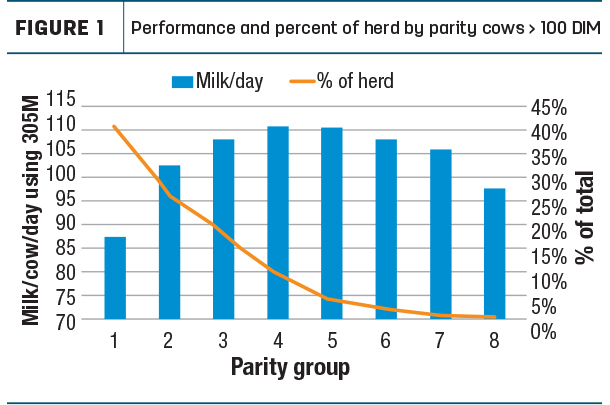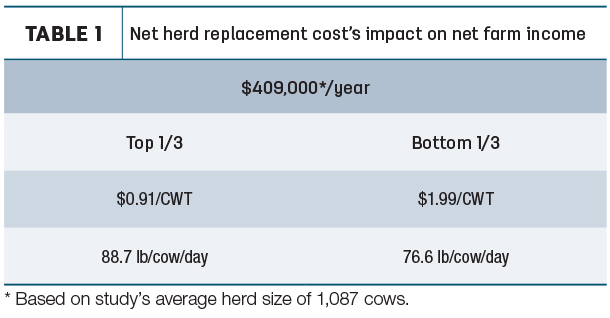While working alongside dairy producers, I hear a lot of myths about raising heifers. Producers often end up “hoarding” their heifers, even though the investment required to raise every heifer is draining their bank account.
Adding every heifer to the milking string means you are potentially pushing out older, higher-producing cows. That leads to lower milk production and decreased profitability. Think long and hard before replacing that productive cow with a heifer.
A first-lactation animal makes 15 percent less than a second-lactation cow – and 25 percent less than cows in their third or fourth lactation. Calving in surplus heifers can push out cows in the prime of their careers, when they have finally paid off their rearing costs and are generating profit.
Heifer raising is about raising the right kind of heifers for your dairy, not just raising every heifer. Let’s look at how you can overcome the urge to hoard your heifers.
Myth No. 1: More heifers mean more money in the bank
Let’s clear this up first. Raising heifers to breeding age and beyond is expensive, and if you are investing in more heifers than you need, you could be decreasing your overall profit.
Heifer rearing is often the second- or third-largest expense on a dairy, costing up to $2,200 to raise a heifer from birth to springing. In fact, a good rule of thumb is: A cow doesn’t cover her up-front costs until midway through the second lactation. High input costs mean you invest a significant amount of capital long before that heifer starts making money.
Milking too many first-lactation animals can decrease the average production of the herd, reduce parlor efficiency and rob profits. The bottom line: Hoarding every heifer can drain your dairy financially.
Myth No. 2: A dairy needs every heifer to manage herd turnover
Dairying is different today than it was 20 years ago. Sexed semen, synchronization programs and increased fertility of the Holstein cow have made it easier to create a lot of heifers. Keeping every heifer as a replacement is not necessary to successfully manage herd turnover. In fact, our recent study with Compeer Financial showed how managing herd turnover cost to be as low as possible can increase profitability.
 The study analyzed 11 years of herd data from 489 year-end financial and production-record summaries with an average herd size of 1,087 cows and identified net herd turnover cost as a key dairy financial driver. When sorted for net herd turnover cost, the difference in production between the top third and bottom third of herds in the study was 12 pounds of milk per cow per day, adding up to $376 per cow per year in net farm income.
The study analyzed 11 years of herd data from 489 year-end financial and production-record summaries with an average herd size of 1,087 cows and identified net herd turnover cost as a key dairy financial driver. When sorted for net herd turnover cost, the difference in production between the top third and bottom third of herds in the study was 12 pounds of milk per cow per day, adding up to $376 per cow per year in net farm income.
Additionally, the bottom herds in the study had actual net herd turnover costs double those of the top herds – $1.99 and 91 cents, respectively. (The study’s results were based on an average herd size of 1,087 milking cows.)
While you need to have replacement heifers, it should not be at the expense of older milking cows. Older cows can actually make more money for you, given they produce more milk than a first-lactation animal and have been in your herd long enough to cover up-front expenses. Once an animal has “paid her bills,” every pound of milk made above feed costs is money in the bank.
To balance your net herd turnover cost, set a goal for a turnover rate between 25 and 30 percent. This will allow you to maintain a fresh source of animals with high genetic potential while still allowing cows to reach lifetime production peaks.
Myth No. 3: Culling is too random
If you are culling based solely on spur-of-the-moment health issues, you are missing an opportunity to build the future of your dairy. Thanks to new genetic technologies in our industry, you can stop guessing and more accurately identify animals most likely to survive and thrive.
 Genomic testing can reveal which cows have the genetic potential to advance your dairy and help meet your goals. By using a genomic test that includes wellness traits for diseases such as mastitis, lameness, metritis, ketosis, displaced abomasum and retained placenta, you can select animals less likely to fall ill with some of the costliest diseases and advance to the production prime of their careers.
Genomic testing can reveal which cows have the genetic potential to advance your dairy and help meet your goals. By using a genomic test that includes wellness traits for diseases such as mastitis, lameness, metritis, ketosis, displaced abomasum and retained placenta, you can select animals less likely to fall ill with some of the costliest diseases and advance to the production prime of their careers.
In fact, you can identity disease risk even earlier in a cow’s life by genomic testing with calf wellness traits to identify risks of respiratory disease, scours and livability. A good genomic testing plan can help you demystify culling and build a better herd for increased profitability.
Here’s how to stop hoarding
You may traditionally keep every heifer for a replacement, but advances in technologies and genetic practices have improved your efficiency with reproduction, health and even planning the genetic makeup of your herd. If you haven’t adjusted your heifer selection strategy accordingly, you are probably looking at a heifer surplus. Take these steps to adjust your heifer inventory:
1. Know how many replacement heifers you need to keep a steady flow of milk in the tank. Be sure to consider ideal turnover, culling and expansions.
2. Identify heifers with the genetic makeup to thrive in the milking herd. I challenge you to think long-term about not only production but also health and livability.
3. Calve in only those heifers that meet your productivity goals. Consider which heifers have the potential to stay in your herd for the long term. This strategy will help you better manage herd turnover and keep more of the older, high-producing cows in the herd.
4. Have a plan for the heifers you don’t need. Once you have implemented a culling strategy using genomics to eliminate animals with a low chance of being profitable, breeding some cows with beef bulls can create an increased revenue stream. However, it is critical to incorporate beef, sexed and conventional dairy semen appropriately to obtain the correct number of heifers.
Bottom line, keep only the heifers you need and strategically align your heifer-raising strategy to improve overall profitability on your dairy.
Do you know your dairy’s peak production ‘sweet spot’?
When your milking herd consists predominantly of early lactation cows, production potential is lost on cows that aren’t producing enough milk to pay their bills. In this example, the bars represent the pounds of milk per cow per day for each lactation group. The line indicates the number of cows in each lactation group.
The decreasing slope indicates a declining number of mature cows (third lactation or greater) compared with early lactation cows. Cows typically are in peak milk production range during the third to seventh lactations. Increasing cow numbers in the “sweet spot” of peak production should be your goal to maximize production and optimize net herd turnover cost. ![]()
References omitted but are available upon request. Click here to email an editor.

-
David Erf
- Geneticist - U.S. Dairy Technical Services
- Zoetis








